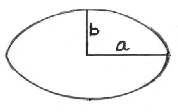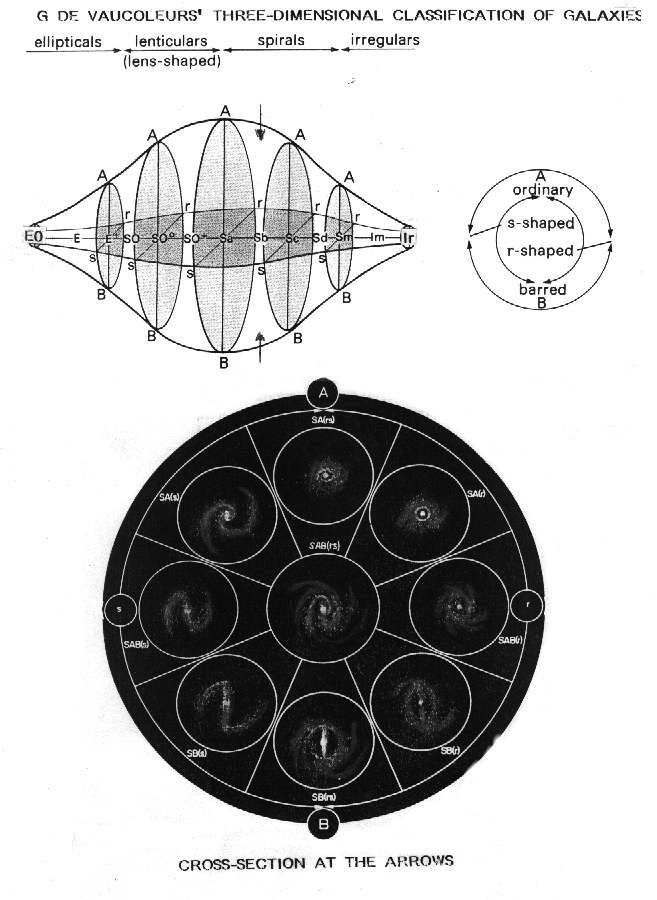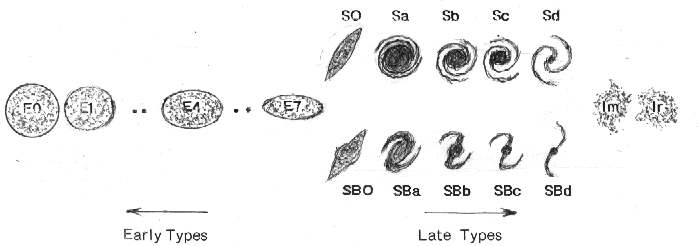CLASSIFICATION OF THE GALAXIES
During the 1920's E P Hubble, assisted by M L Humason and V M Slipher,
using the 2,5 metre (100 inch) Mount Wilson telescope, found that the galaxies are all
receding from each other and the fainter they are (and thus the further) the faster they
are receding. This was known because their redshifts got greater as the galaxies got
fainter. The H- and K- lines of ionised calcium in the spectrum, were the phenomena that
made this determination of redshift possible.
Hubble noticed that there were many and varied forms (shapes) of
galaxies and he decided to classify the galaxies according to their shapes and forms, a
morphological classification. This classification implied no evolutionary sequence.
Firstly, some galaxies were found to be evenly filled with stars. They
were spherical and elliptical in form. Hubble classified the sphericals as E0 and the
ellipticals as El, E2,..E4...E7, the numbers increasing with increasing
flatness.

|
If a and b are the semi-major and minor axes of the ellipse,
the ellipticity is given by ( a - b ) ÷ a. The diagram illustrates the relative
amount of flattening of an E4 galaxy. The flattest ellipticals are the E7 types. The
remaining galaxies were not evenly filled with stars but had streams of stars in the
form of spiral arms. Of these, some had a bar through the middle with spiral arms trailing
from the ends of the bar. The galaxies with spiral arms were typified |
by Hubble as Sa, Sb and Sc for the types in which the spiral arms
sprout from the nucleus of the galaxy, and SBa, SBb and SBc for those in which the spiral
arms sprout from the ends of the bar.
There were also intermediate types of lenticular shape. These
lens-shaped galaxies he typified as S0 and SB0, the latter having a semblance of a central
bar. Galaxies that were irregular in shape, such as the two Magellanic Clouds, were
typified by Hubble as Irr.
Diagrammatically the Hubble Classification had the appearance of a
two-pronged fork as shown in the diagram, which also contains types Sd and SBd, which were
added later.
Although Hubble implied no evolutionary sequence, galaxies to the left
of the classification became known as "early types" and those to the right as
"late types" (not including the irregular types).
The amounts of interstellar gas and dust increase from Sa to Sd and
from SBa to SBd and this may, or may not, be an indication of greater age. Different types
of galaxies contain all classes of highly-evolved stars (red supergiants) so that they
must all be around the same age, 1010 years (ten thousand million years). In
the article on the Evolution of the Galaxies we saw that this age is concomitant with a
Hubble constant of 100 kilometres per second per megaparsec ( km s-1 Mpc-1
).
Since the masses of the galaxies differ greatly, there can be no talk
of one type of galaxy evolving into another type. The angular momentum (speed of turning
multiplied by mass) increased from type Sa to Sd and from type SBa to SBd and from El to
E7. Greater angular momentum is responsible for an increase in the spread of the spiral
arms.

The diagram shows that (i) the nuclei of the galaxies get smaller from
a to d, and (ii) the spread of the spiral arms gets greater, from tightly wound in a to
very loose in d.
Over the years more detail has been introduced into the classification,
particularly by A Sandage and G de Vaucouleurs. The S0 classes have been divided into
three and labeled S0- , S0° and S0+. These can be considered as
running parallel to the S a b c d sequence but without any spiral arms and containing much
less gas and dust. S van den Bergh has described a sequence of gas-poor
"anaemic" spirals intermediate between S and So which are common in clusters of
galaxies. Van den Berg found that the appearance of an Sb, Sc or irregular I galaxy is
related to its luminosity, for example the most luminous galaxies have the longest, most
fully developed spiral arms. He therefore introduced luminosity classes I to V in
increasing order of brightness. His luminosity classification of galaxies gives a simple
method of obtaining the relative distances of large numbers of spiral galaxies. The
irregular types have been split into two: Im and Sm, the latter containing slight but
definite traces of spiral structure. The Large Magellanic Cloud is typified as SBm.
Intermediate types have been indicated by combining symbols such as Sab
or SBab, etc. Also small s has been added to indicate that the spiral arms sprout from the
nucleus and small r to indicate that the spiral arms sprout from a ring around the
nucleus, giving types such as Sb(s) or Sb(r) etc, using (rs) for intermediate types.
De Vaucoleurs also calls for the ordinary spirals to be typified SA,
keeping SB for the barred spirals. The two series are thus SAa, SAb, SAc, SAd and SBa,
SBb, SBc, and SBd, with provision for intermediate types such as SAB. Strong, dense spiral
arms are to be indicated by m or f.
De Vaucouleurs has developed his system into a three-dimensional
diagram consisting of a series of circles with SAB(rs) in the centre, with ordinary
spirals A, above and barred spirals B below. Left of the centre there is SAB(s) and to the
right SAB(r). The (rs) indication thus spans the circle from top to bottom. The A and B
types to the left are all (s) and the A and B types to the right are all (r).
Through the centres of the five vertical circles, De Vaucouleurs has E+
, S0-, S00, S0+, Sa, Sb, Sc, Sd and Sm with E0 and E to
the left of the vertically standing circles and Im and Ir to the right of the circles.
The top diagram gives the isometric view, of the circles seen obliquely
and the lower diagram gives the cross-section of the central circle.
W Morgan has called for giant ellipticals to be placed in a special
class cD. They are large and bright and have extended envelopes and most of them are
strong radio sources.
Among the bright galaxies, spirals account for about 75% of the total;
ellipticals and S0 types for 20% and Irregulars for 5%. The relative numbers vary with
limiting magnitude, far when the galaxy is very faint, it cannot with certainty be
classified. There are many dwarf ellipticals, classed as dE. For galaxies as a whole, the
number of ellipticals probably exceeds 60% and there are probably three times as many
spirals as irregulars.
The three groups, Spirals SA; barred spirals SB and the intermediate
group SAB are present in about equal numbers.
Eben van Zyl


